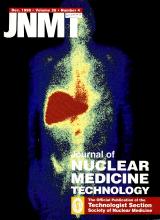Abstract
Objective: Videotape images of 30 volunteers were used to classify and measure head movements that may occur during brain imaging.
Methods: A simple videotape setup was designed to record simultaneously the lateral and vertex views of the subject’s head. Volunteer subjects were positioned for brain imaging and their heads were videotaped for 2 hr. Head movement was identified and measured.
Results: All subjects demonstrated angular movement within the transaxial plane (rotation of the head). There was angular movement in the sagittal plane and translation of the transaxial plane. There was no movement of the coronal plane, nor was there any translational movement of the sagittal plane.
Conclusion: The most dominant head movement was rotation. The effects of other factors such as height, weight, age, smoking habits, and caffeine and alcohol intake could not be determined with this sample size.







